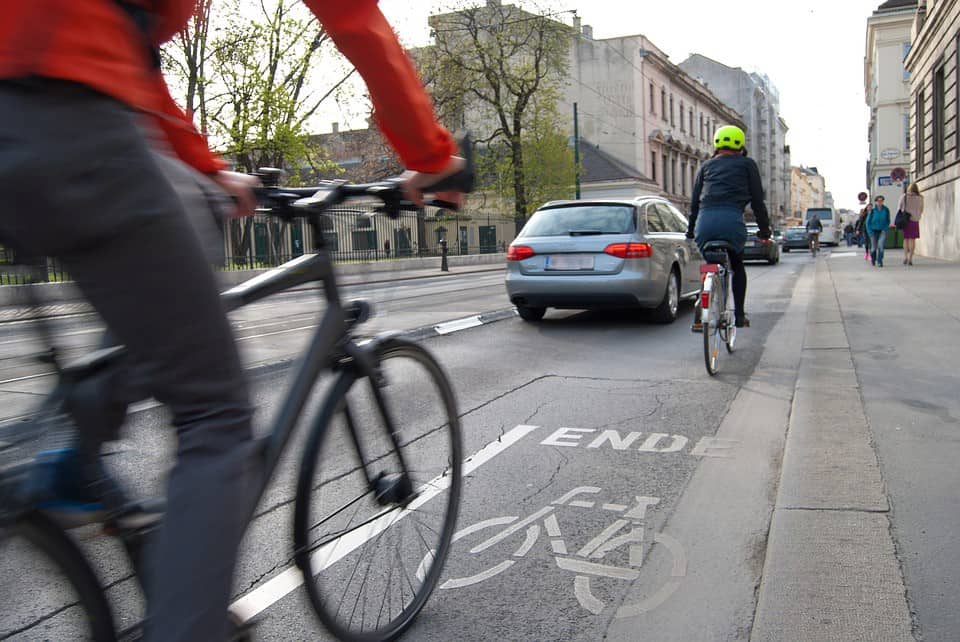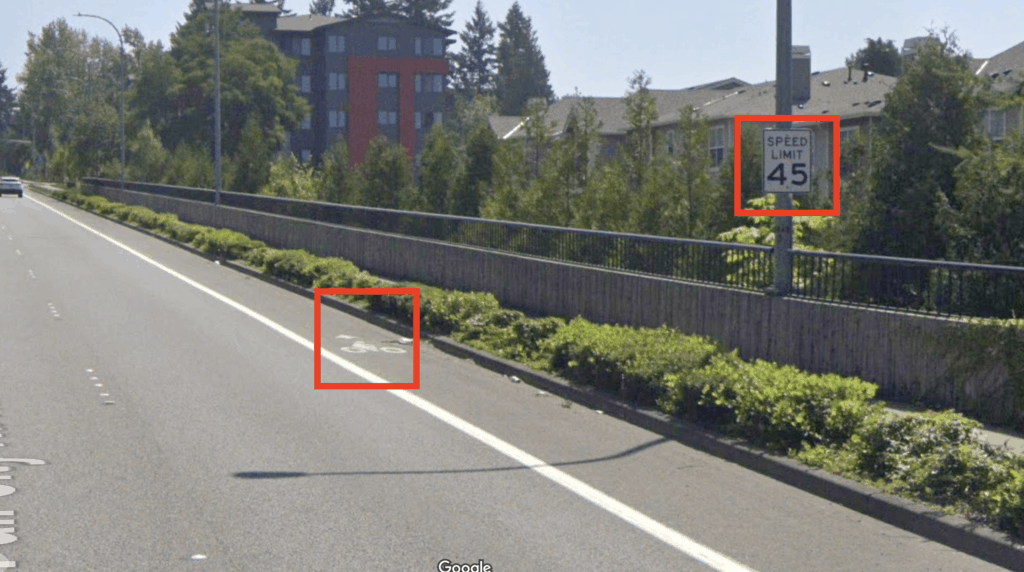Last updated: July 17th, 2023
Bicycles have the speed of (slow) cars but the vulnerability of pedestrians, so these three don’t mix well in the city.
Some places address this with physical infrastructure that keeps everyone separate and—especially for cars—enforces prudence and awareness.
Other places don’t.
For example, most of the US has little more than painted bike lanes and inconsistent (if any) enforcement of laws protecting cyclists in traffic. This requires extraordinary safety measures, which make riding stressful and discourage the vast majority of people from cycling in town.
Between many years of firsthand cycling experience, travel to more bike-friendly cities, and a review of urban planning research, this list highlights four best practices that are easy to implement yet too often overlooked.
It’s not a complete list nor am I an urban planner.
But the good news is the most effective practices are far from rocket science!
With a little common sense, and political will to match, we can make it safe for everyone to get around without dangerous, polluting, and exorbitantly expensive vehicles.
This article might contain affiliate links. As a member of programs including Amazon Associates, I earn from qualifying purchases.
Why good bicycle infrastructure is worth building
Good bicycle infrastructure saves lives and encourages healthful, sustainable, and extremely cost-effective transportation. It even makes streets safer for drivers by reducing speeds and encouraging situational awareness. Likewise, pedestrians benefit from better crossings, dedicated space, and less traffic noise.
In brief, it’s something people of all ages and fitness levels can use without danger or stress. In other words, good bicycle infrastructure is what children and grandparents alike can safely use for daily needs.
What’s more, good and safe infrastructure increases cycling rates, which further boost safety through the “safety in numbers” effect. When any mode of transportation crosses some threshold of visibility, it becomes significantly safer for all involved.
Here are bicycle infrastructure best practices in brief
Bicycle infrastructure best practices include thoroughly interconnected bike routes, physical separation (especially at intersections), road features to slow vehicles down, and totally separated routes when higher speeds are necessary.
These emerge almost naturally when planners view city streets as a means of moving people, not just moving automobiles.
For instance, another good practice is to create more direct routes for bicycles than for cars. This allows more people to pass through crowded areas without the congestion and risk of through-traffic. It also adds driving time and cost that discourage car use when it’s not truly necessary.
Note: it’s often argued that there’s no sense building bike infrastructure where nobody rides. However, the best practice is precisely the opposite: eliminate the danger with a well-built route, and simply watch as people adopt it.
1. Only connected infrastructure counts
It’s common to see a beautiful, protected, downtown bike lane as a demonstration or pilot project.

However, they tend to be standalone projects that are only accessible via poor or missing infrastructure. Consequently, few people cycle there who weren’t going to anyway.
The effect on cycling rates is small despite the good design, so voters object to the cost and construction disruptions, and oppose future bike infrastructure on the basis of these well-meaning but poorly executed pilots.
It’s like building a beautiful resort in the middle of a dangerous ghetto, and arguing that the lack of visitors means nobody actually wants to visit a resort.
2. Precisely control travel through intersections
The value of protected bike lanes is self-explanatory, but most come to an abrupt end at intersections. This creates ambiguous or conflict rights-of-way that are disconcerting to drivers, cyclists, and pedestrians alike.
In others words, this:

The majority of collisions that injure cyclists happen at intersections, and drivers’ failure to yield right-of-way is the largest cause by far.
On one hand, nothing excuses less than attentive driving, period.
On the other hand, common North American intersection design actively creates conflicting rights of way between cars, cyclists, pedestrians.
Some are a result of traffic controls:
- Right turns on red lead to unpredictable and often aggressive turning
- Green lights that coincide with walk signals, so drivers must go through a crosswalk that may be occupied
- Unprotected left turns also coincide with walk signals, with the same effect
- Generally excessive speed limits
Others are a result of how intersections are physically arranged:
- Right turn lanes that drivers must cross a bike lane to enter
- Corners with a large, smooth radius that’s conducive to high speed
- Non-right-angles that make it even harder to see cyclists/pedestrians from a car
- Cyclists must often cross car lanes to turn left, and remain a “sitting duck” while waiting
Fortunately, this problem has already been solved. The best practice for intersection design (especially in the city) is to use “island” curbs that force cars into slower turns with a clearer view of cyclists, while keeping cyclists on a predictable and protected path. This also provides a safe solution to the sitting-duck problem for left turns.

3. Slow cars down with features, not signs
Lower car speeds make roads safer for everyone—drivers included. Speed-limit reductions avert many collisions in the first place, and reduce the severity of injuries when collisions do occur.
The best way to reduce cars’ speed is not through signs, but through physical features that make lower speeds feel natural. This is important in town, where cars frequently mix with cyclists and pedestrians.
As we all know, simply posting a speed limit sign is rarely enough. There is a strong human tendency to drive up to whatever speed it feels like the road was designed for. That may or may not match the posted limit.
For instance, if you’ve ever driven around the suburban American southwest, for instance, then you know how incongruous—even frustrating—it feels to follow a 30-mph speed limit on a straight, eight-lane boulevard. Consequently, some drivers simply disregard it. And many more slowly pick up speed without realizing it due to the lack of environmental feedback.
But when city streets are narrower, curvier, or less perfectly smooth, we become more aware of our vehicle’s motion. It’s both impractical and unintuitive to drive faster than the road feels made for.

A related point is that collision injuries are less severe at orthogonal (right-angled) intersections. That’s probably because right angles encourage lower speeds (due to a narrower turning radius) and minimize blind spots from the driver’s seat.
4. Create separate routes for higher speeds
Sometimes, there’s a need for more open roads with higher speeds for cars. Freeways/expressways are the most obvious example, but so are smaller highways between or around towns.
Above typical city speeds of about 30 km/h or 20 mph, it’s best to keep car and bicycle traffic completely separate. It’s hard to observe small, slow objects from faster speeds, so separation reduces the need for drivers to do so. Likewise, cycling alongside fast traffic ranges from anxious to downright horrifying, so separation puts cyclists at ease (and may reduce how much exhaust they’ll inhale).

Corollary: encourage in-fill development
Reasonably high population density makes it more efficient and fun to cycle or walk. Of course, actually changing density goes much deeper than bicycle infrastructure best practices.
But by and large, it gets more practical to cycle when (for example) cities fill in city-center parking lots with mixed-use development, or up-zone to allow more middle-density housing.
These solutions can be complicated on several levels, but it’s important to remember that even world-class bicycle infrastructure won’t see much use unless people can affordably live within cycling distance of daily needs.
